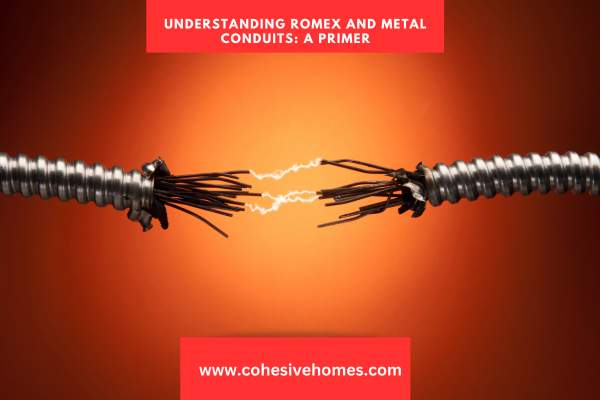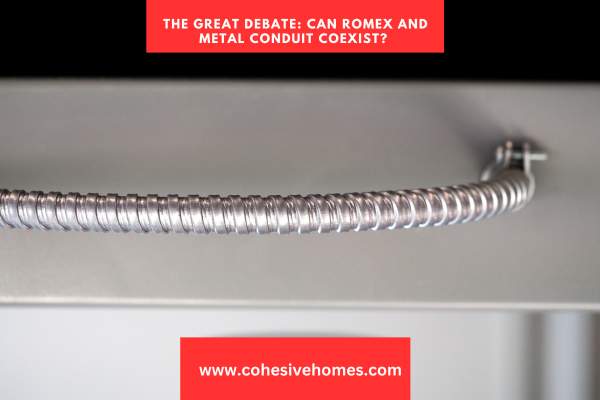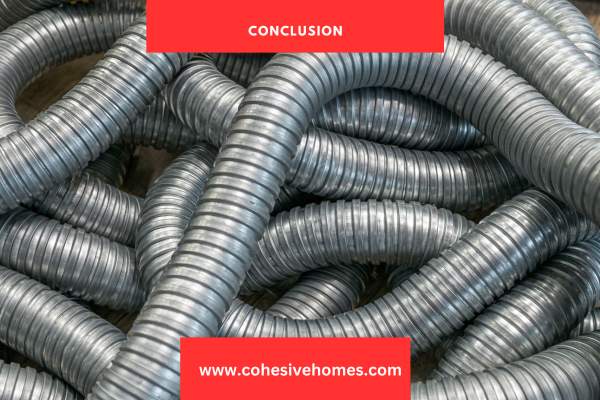Hey there, fellow DIY enthusiasts and electrical aficionados! If you’ve ever found yourself knee-deep in a wiring project, you know just how important it is to make informed decisions about the materials and methods you use. Today, we’re diving into a hot topic that often sparks debates among electricians and homeowners alike: Can You Run Romex In Metal Conduit?
Should it be done? Well, get ready to untangle the wires of confusion because we’re about to shed some light on this electrifying matter!
In this blog post, we’ll explore the ins and outs of running Romex® in metal conduit. and everything in between.
We’ll tackle common misconceptions, delve into code requirements, and even touch on some practical considerations.
So, whether you’re a DIY enthusiast looking to upgrade your electrical system or a professional electrician seeking clarity on this intriguing topic, you’ve come to the right place.
Understanding Romex and Metal Conduits: A Primer

Romex is a type of non-metallic sheathed cable that has gained popularity in residential electrical installations.
It consists of multiple conductors, usually made of copper, surrounded by a plastic outer jacket.
Romex is known for its versatility and ease of use, making it a favorite among DIY enthusiasts and electricians alike.
Its non-metallic construction allows for flexibility and simplifies installation, especially in areas where bending and maneuvering are required.
On the other hand, metal conduit has long been regarded as a reliable method for protecting electrical wiring.
It comes in various types, including rigid, intermediate, and flexible. Metal conduit is primarily made of steel or aluminum and provides excellent protection against physical damage, such as impact or exposure to moisture.
It also offers superior grounding capabilities, reducing the risk of electrical shock and providing enhanced safety.
When considering the combination of Romex and metal conduit, it’s important to understand that Romex is typically designed for use in residential applications where it can be installed directly within walls, ceilings, or floors.
It is not intended to be used in conduit systems. On the other hand, metal conduit is commonly used to house and protect individual wires or cables, particularly in commercial and industrial settings.
It’s essential to follow electrical codes and regulations specific to your location when working with Romex and metal conduit.
These codes outline the proper usage and installation methods for each component, ensuring electrical safety and compliance.
It’s worth noting that some codes strictly prohibit running Romex in metal conduit, while others may allow it under certain conditions.
The Great Debate: Can Romex and Metal Conduit Coexist?

The combination of Romex and metal conduit in electrical installations has long been a subject of debate among electricians and homeowners.
On one side of the argument, there are those who firmly believe that Romex and metal conduit should never be used together.
Their main concern revolves around compliance with electrical codes and manufacturer recommendations, which often discourage or prohibit running Romex in metal conduit.
These codes and recommendations emphasize the specific design and approved uses of Romex as a standalone cable, highlighting potential safety risks and difficulties in installation when it is placed inside metal conduit. Additionally, some argue that combining Romex and metal conduit may lead to issues such as moisture accumulation, insulation damage, and overheating due to reduced heat dissipation.
As a result, proponents of this viewpoint advocate adhering strictly to code requirements and using alternative wiring methods when metal conduit is involved.
Demystifying Code Requirements: What the NEC Says

When it comes to electrical installations, adhering to electrical codes is paramount for ensuring safety and compliance. In the case of running Romex in metal conduit, the National Electrical Code (NEC) provides guidelines and regulations that shed light on this contentious topic.
Let’s demystify the NEC’s stance on the matter and explore the key code requirements related to combining Romex and metal conduit.
- NEC Article 300.3(A): Wiring Methods Limitations
- The NEC states that conductors and cables must be installed in a manner consistent with their listing and labeling.
- Romex is listed and labeled as a non-metallic sheathed cable, designed for direct installation without the use of conduit.
- This code provision suggests that running Romex in metal conduit may violate the intended use and listing of the cable.
- NEC Article 300.3(B): Separate Wiring Systems
- The NEC emphasizes that different wiring systems, such as non-metallic sheathed cables and metal conduit, should be installed separately.
- The purpose of this requirement is to maintain the integrity and performance of each wiring system, as they are designed to operate independently.
- NEC Article 300.20(A): Protection Against Physical Damage
- Metal conduit is primarily used to provide protection against physical damage to wiring.
- Romex already has its own built-in sheathing, which offers a certain level of protection.
- Combining Romex and metal conduit may be seen as redundant, as it may not provide any additional benefit in terms of physical protection.
It’s important to note that specific code requirements may vary depending on the jurisdiction and local amendments.
Therefore, it’s crucial to consult the NEC and any local electrical codes applicable in your area to ensure compliance.
While the NEC does not outright prohibit the combination of Romex and metal conduit, it strongly emphasizes adherence to the intended uses and limitations of each wiring method.
Safety First: Practical Considerations for Running Romex in Metal Conduit

While there may be debates and code restrictions surrounding the combination of Romex and metal conduit, it’s essential to prioritize safety when considering any electrical installation.
If you’re contemplating running Romex in metal conduit, there are several practical considerations to keep in mind to ensure a safe and efficient wiring system.
Let’s explore these considerations and weigh the potential advantages and challenges associated with this approach.
Space and Conduit Size
Running Romex in metal conduit can increase the space required for installation. Consider the size of the conduit, especially when dealing with tight spaces or existing walls where retrofitting may be necessary.
Ensure that the chosen conduit size can accommodate the Romex cable without causing excessive bending or damaging the cable insulation.
Heating and Cooling Effects
Metal conduit can affect the heat dissipation characteristics of Romex cables. The confined space of the conduit may trap heat, potentially leading to insulation degradation or overheating of the conductors.
Adequate ventilation and proper conduit sizing can help mitigate heating issues. Consider consulting a qualified electrician to assess the heat dissipation requirements for the specific application.
Moisture and Grounding
Metal conduit offers superior protection against moisture ingress, which can be advantageous in damp environments.
Proper grounding is crucial when running Romex through metal conduit. Ensure that the conduit is effectively grounded, maintaining electrical safety and preventing the risk of electric shocks.
Pulling and Installation Challenges
Pulling Romex through metal conduit can be more challenging compared to traditional wire installations.
The friction between the cable and the conduit may require additional effort and tools for smooth and damage-free pulling.
Take extra care during installation to prevent any sharp edges or rough surfaces in the conduit that could damage the Romex cable insulation.
Accessibility and Future Modifications
Consider the accessibility requirements for maintenance or future modifications. Running Romex in metal conduit can make it more complex to access or replace individual cables compared to direct installations.
Remember, the safety of your electrical system should always be the top priority.
It is advisable to consult with a qualified electrician or local electrical authority before proceeding with any unconventional wiring methods.
They can provide expert guidance based on your specific project requirements and local electrical codes, ensuring a safe and compliant installation.
Common Misconceptions Debunked: Separating Fact from Fiction

There are a number of myths and contrasting views on running Romex in metal conduit that are prevalent.
To get a better knowledge of the truths and restrictions related to mixing metal conduit with Romex, let’s dispel some of these widespread myths and distinguish fact from fiction.
One prevalent myth is that running Romex in metal conduit provides superior protection.
The fact is that while metal conduit does offer excellent protection against physical damage, the Romex cable itself already has its own built-in sheathing, providing a certain level of protection.
Placing Romex in metal conduit may not provide additional benefits in terms of protection and can even restrict heat dissipation.
Another misconception is that running Romex in metal conduit is always against code regulations.
In reality, the National Electrical Code (NEC) does not explicitly prohibit running Romex in metal conduit.
However, it does emphasize following the listing and labeling of the cable and adhering to separate wiring systems.
Local electrical codes may have specific requirements regarding the use of Romex in metal conduit, so it’s crucial to consult the applicable codes in your area.
Some may believe that running Romex in metal conduit guarantees better grounding. While metal conduit provides an effective grounding path,
Romex cables have their own grounding conductor. Running Romex in metal conduit may offer some additional grounding benefits, but it should be installed and bonded correctly to ensure a reliable grounding system.
Misconception
There is also a misconception that running Romex in metal conduit is more cost-effective.
The fact is that the cost-effectiveness of this approach can be subjective and dependent on various factors.
Consider the added cost of purchasing and installing metal conduit compared to using Romex without conduit.
Moreover, the complexity of pulling and installing Romex in conduit may require additional time and effort, impacting overall project costs.
The Professional Perspective: Electricians’ Take on Romex in Metal Conduit

Electricians are experts in running Romex in metal conduit, but it is not a commonly recommended practice.
Their perspective offers valuable insights into the feasibility, safety, and best practices associated with this contentious topic.
Let’s explore the professional perspective of electricians on the subject of combining Romex and metal conduit.
Safety Considerations
Electricians prioritize safety above all else. Many electricians caution against running Romex in metal conduit due to concerns about heat dissipation, potential insulation damage, and difficulty detecting and resolving issues within the conduit system. They emphasize the importance of following electrical codes and manufacturer recommendations to ensure the highest level of safety for both the electrical system and the occupants of the building.
Compliance with Electrical Codes
Electricians are well-versed in the electrical codes and regulations that govern their work. They emphasize the significance of adhering to code requirements specific to each jurisdiction. While the NEC does not explicitly prohibit running Romex in metal conduit, electricians pay close attention to any local amendments or restrictions that may apply. They prioritize compliance to avoid potential liabilities and ensure that installations meet the highest standards.
Practical Challenges
Electricians highlight the practical challenges associated with running Romex in metal conduit. Pulling Romex through conduit can be difficult and time-consuming, requiring specialized tools and techniques. Moreover, the additional space required for the Romex within the conduit may pose challenges in retrofitting or tight spaces.
Consider alternative wiring methods as recommended by electricians for better suitability to specific project requirements.
Alternative Wiring Methods
Many electricians advocate for using alternative wiring methods when metal conduit is desired. They suggest using individual THHN/THWN wires, which are specifically designed for use in conduit systems. This allows for easier pulling, better heat dissipation, and more efficient use of the conduit. Alternative wiring methods help electricians comply with codes and minimize risks when avoiding the combination of Romex and metal conduit.
Conclusion

Electricians bring a wealth of knowledge and experience to the discussion of running Romex in metal conduit.
Their perspective emphasizes safety, compliance, and practical considerations. While opinions may vary, it is clear that electricians prioritize following electrical codes, ensuring proper heat dissipation, and selecting the most suitable wiring method for each project. Consulting with a qualified electrician is always recommended to make informed decisions and ensure a safe and reliable electrical installation.
